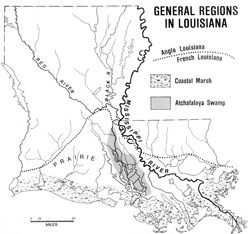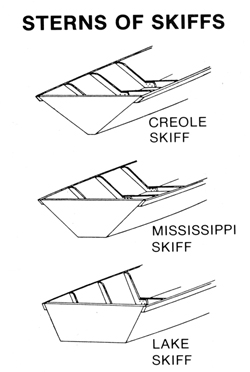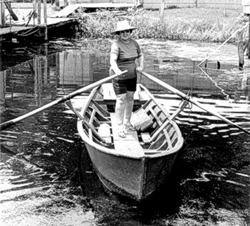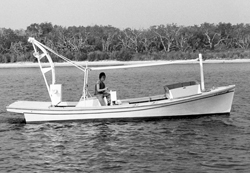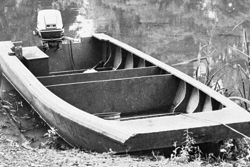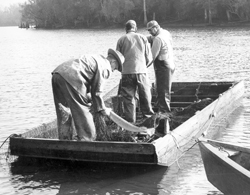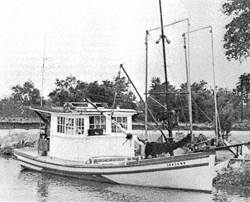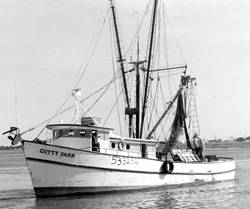Table of Contents
Louisiana Folklife: An Introduction
Folklife Research in Louisiana
Ethnicity, Region, Occupation and Family
Living On and Off the Land in Louisiana
Documenting Tradition
Folklife and Public Policy
Appendices

Folk Boats of Louisiana
By Malcolm Comeaux
This essay originally appeared in Folklife in Louisiana: A Guide to the State published by the Office of Cultural Development in 1985. This essay is provided online courtesy of the editor since the publication is out of print.
Editor's Introduction
Folk boats are those wooden craft made by hand in forms that have been handed down over time and learned by each generation of builders through imitation, oral instruction and practice. Such boats are traditionally constructed by their users or acknowledged local makers. Their work function in a subsistence and cash economy is food and other resource gathering and transportation. To understand boats' significance and their forms it is also important to look at their cultural sources and the social dimensions of their construction and use.

Indians provided the model for what is now called the pirogue-a boat associated today with Cajun culture. Historical French/Mediterranean influence was felt in some boat types and especially with regard to the practice of forward facing, stand up rowing with the brace device for oars called a joug. Yet this time-honored practice is disappearing in the wake of metal flake, sport boats of the pleasure seeker as well as the engine powered, folk-derived craft of the contemporary subsistence and commercial fishermen. Although north Louisiana is not known as an area for boat making, Anglo-American up-river ancestors often floated their way down stream on rafts and barges that provide sources for the flatboat. Perhaps the most recent cultural connection in boat form and function is the apparent linkage of the oyster lugger of south Louisiana to the Dalmatian coast of Yugoslavia from which have come Slavonian immigrants over the last century. If a diversity of cultures has contributed to Louisiana's boat types, the diversity of ecological niches in which they must function has also given impetus to modification of style and use over time from the pirogue that can "float on a dew" in shallow swamps and marshes to the steady barge that can support a house. However, Louisiana's boat types and the strength of this on-going tradition of building and use are barely recognized or documented in the state. Louisiana, along with other coastal states like Maine, Maryland, and Oregon, has a vibrant set of boat traditions that we take for granted while marine architects from afar are amazed at the economy and beauty of a Lafitte skiff made entirely from unwritten plans.
New folk houses are rarely constructed today, but they are still lived in and thus provide a visible connection to the heritage of the past. Folk boats are constantly refurbished, made anew and modified as to material. As such they are cultural vessels that join the regional heritage of the past to the future pursuit of food and other water-related resources.
In the article that follows, Malcolm Comeaux updates the landmark work of William Knipmeyer (1956) which was reprinted in 1976 as "Folk Boats of Eastern French Louisiana." Comeaux draws upon his in-depth work with Atchafalaya Basin boats and culture and expands to include coastal and deep-water craft as well as boats up river in north Louisiana and beyond.
Dr. Comeaux is a native of Lafayette and has also written about Acadian accordions and the Spanish Moss industry. He now resides in the very dry state of Arizona where he is a Professor of Geography at Arizona State University.
Introduction
Folk boats of Louisiana are an excellent vehicle for the study and understanding of material culture. There are several basic styles of folk boats, and each has changed and evolved through time and space. These changes have come about as a result of the varieties of environments exploited, new technology that is introduced or locally developed, and changes in the world at large, as for example the development of roads, or the desire for new water-related sources (as shrimp, crawfish, or oil). Most Louisiana fishermen are conservative, and do not want to change, but as fishermen everywhere in the United States, they are tied to the national economy, for they must sell their products and buy goods from the surrounding society. Changes in boat technology are inevitably forced on fishermen, but these changes are molded by people to fit their ideals, needs, and knowledge, and in these changes there is continuity, as the new ways are superimposed on the old. In this manner some boat types are abandoned, while others evolve and change.
Boat types used today are the result of the interplay of culture, environment, and technology. A person reared in a particular culture will have preconceived ideas of how to build and use boats, and this background will help determine what boats are used, and what changes are made in any boat style. Environments will also help determine boats and their use, as Louisiana watercraft are used in deep oceans and shallow coastal lakes, in large powerful rivers and in shallow, quiet bayous, and in marshes and swamps. There are boat types particularly suited to each of these environments. The last factor influencing boat styles is technology, and it offers the greatest opportunities for rapid change. As new technology is introduced, watercraft are changed to fit the new technology, and where the two can successfully blend, a new boat type quickly develops. Boats that cannot successfully use the new technology are often abandoned, except where particularly adapted to a task or environment.
A study of small working boats is difficult for two reasons. One is because boats have been ignored by scholars. A great amount has been written on steamboats and sailboats because of the romanticism associated with them (Glassie 1976: 105), but the small, sometimes dirty, working boats are considered prosaic, and so have been ignored. A second reason for the difficulty is the lack of standard terminology to describe boat types. Any small change in a boat design will cause a new name to be used to describe it, and, of course, names to describe the variation will vary from one region to the next, with confusion the result.
Only a small percentage of the people in Louisiana are today dependent on boats for work or transportation. Most Louisianians are urban dwellers and have little need for boats, except for recreational purposes. The same can be said for farmers and those persons living in small towns away from streams or the coast. Where boats are important, however, they are of critical significance, and in these areas a great amount of boat tradition is found. There are two broad traditions concerning boats extant in Louisiana: that found in northern, or Anglo Louisiana, and that found in southern, or French Louisiana (for a study of the north-south boundary line, see Newton 1975). One other fact about boats and people should be mentioned; black people of Louisiana do not have a boat tradition. Blacks have traditionally been associated with agriculture and cities, and they have never been associated with commercial fishing in inland waters.
Boat building and use traditions have never been as diversified or strong in Anglo Louisiana as opposed to French Louisiana. North Louisiana was settled by Southerners moving westward, and boat building and fish consumption was never important in this culture (Comeaux 1978: 91 and Padgett 1963: 27). Fishing, meanwhile, was very important along the Upper Mississippi and Illinois River systems, and fishermen from these areas drifted into north Louisiana. Boat traditions, however, were important only to the "river rats" and fishermen along rivers, and this way of life has largely ended, along with many of the boat traditions (Gregory 1966).
Boat traditions in south Louisiana, the area of French influence, have always been strong and varied. Almost all early French settlements, except for those on the prairies of southwest Louisiana (p. 176), were, along bayous or rivers, and although most early French settlers were farmers, water bodies were always important as sources of food and as transportation routes. One early French writer, in describing the significance of boats to local inhabitants, said (Robin 1966: 100):
People in this country are so accustomed to travel by water that the generic term 'voiture' (standard French for "carriage") is always applied to a boat. If a Louisianan says to you 'I brought my voiture'; 'Can I give you a lift in my voiture; he is referring to his pirogue or skiff as a Parisian using the same word would mean his coach.
Many boat types were used in this early era. Boats quickly evolved to fit ecological niches and particular chores. An observant writer (Robin 1966: 101), who lived in Louisiana from 1803 to 1805, explained the many varieties this way:
This diversity of shape of these boats comes from the diversity in their usage and in the places where they must go. Those that come from the far-off rivers that are wide and shallow are wide and flat in order to draw little water, while those that navigate the surface of the deep rivers must overcome the swift current, are more elongate and draw more water and are heavier. Their thick, rounded bottoms glide over the snags and logs which are found in all parts of the river bed. The narrow bayous where the water sometimes rushes in torrents boats that are shorter and lighter, whereas others still require very light skiffs in order to shoot the rapids or to be dragged over the river bed in low water.
He further stated (Robin 1966: 101) that there were even luxury craft requiring l5 to 20 slaves to row them, and that they were owned by wealthy plantation owners who wanted to flaunt their wealth.
Boats remained important in the lives of many French-speakers until about the 1930s, when an expanding efficient highway system made travel by boats along bayous inefficient. Since that time, the use of folk boats has declined. Many south Louisianians, however, remain employed in the exploitation of water-related resources, so boats continue to be significant, and boat traditions persist.
Although boat traditions are stronger in south Louisiana, there are relatively few differences between the boat types used in inland waters in the two areas. There are just so many ways to build a small craft, and in inland waters these techniques are widely known, from the Gulf Coast to Minnesota. South Louisiana boats differ from those in north Louisiana in the accouterments, the way the boats are used, their far greater numbers, the keeping of relict craft, their diversity of type and their better maintenance (such as frequent paintings,)1 and the use of small sheds to protect boats from inclement weather. There is a considerable amount of overlap between boats used in inland waters and those used in shallow bays and inlets along the coast, but there is a vast amount of difference when comparing boats used in inland waters, and those offshore.
The Pirogue
The term pirogue2 (pronounced many ways, but usually "pero," or "perog") is used throughout Louisiana to refer to a small one- or two-man craft that is flat-bottomed, narrow, and pointed on the ends. To most Americans this craft would be classified as a "canoe," but that term is never used in Louisiana to identify a pirogue. The modern pirogue traces its roots back to Indian dugout pirogues, and it has gone through a long evolutionary process before developing into its present form.3
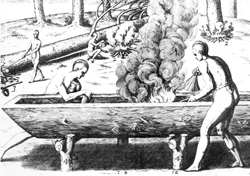
The dugout was the only true boat used by Indians in Louisiana prior to the arrival of Europeans. A few birch bark canoes entered the state with French Canadian explorers, but such craft were not built by Louisiana Indians, most probably because no locally suitable bark was available to build this type canoe.4 Constructing a dugout was a laborious task before the arrival of whites. The Indians had to use fire to both fell the tree and hollow the log (Fig. 1) (Le Page du Pratz 1758, Vol. 2: 188-89; Kalm 1937, Vol. 1: 229-30; and Penicaut 1953: 8-9). Having only fire as a tool, Indian pirogues were crudely made, disproportional, and very thick-hulled (Le Page du Pratz [1758, Vol. 2: 189] says they were three inches thick). The result was a bulky craft that often weighed several thousand pounds. The Indians of Louisiana built their dugouts of cypress, (5) and cypress remained the main building material for dugouts as long as they were built. Early French explorers and settlers quickly recognized the pirogue as an excellent craft for use on inland waters, began acquiring them from Indians and soon were building their own improved models.
The French had steel tools, particularly the ax, adz and auger (or gimlet), and with these tools a pirogue could be quickly and carefully constructed, and made quite light. The ax was used to fell the tree and roughly shape the craft, while the adz was used to hollow out the log. The auger was used to drill holes through the bottom of the craft so the craftsman could check the thinness of the hull (Knipmeyer 1976: 111-15). Other tools to help simplify the task were used when available, such as a saw, knife, hatchet, plane, drawknife, templates, as well as both the foot and hand adz.
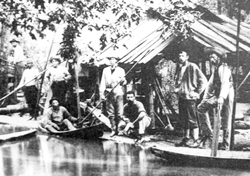
With their tools and their superior knowledge of watercraft, the French built vastly improved versions of the Indian pirogue. In particular, the French changed the shape of the pirogue. Le Page du Pratz (1758 Vol. 2: 188) mentioned that Indian dugouts in Louisiana were blunt ended, and this was generally true of Indian pirogues in the South (Fig. 2). The French made their pirogues pointed on the ends, and this made them easier to propel and more seaworthy. The French also changed the method of building pirogues; as opposed to Indians, they first formed the outside of the log, and then hollowed out the middle. The outer side was very carefully shaped, and French pirogues had equal dimensions and curves on either side of the centerline; this gave them excellent balance. After the outer hull was shaped, and much of the hollowing completed, auger holes were placed along the curvature where the bottom of the craft meets the sides, and also in the very center of the bottom. The craftsman then finished hollowing out the log, using the holes to check the thinness of the hull (the holes were later plugged with pegs when the craft was nearing completion). With these techniques the hull was made of uniform thickness, and without weak spots as might be found in Indian pirogues (where, during the burning, the hull may have become too thin). Being thin-hulled, it was much lighter than Indian dugouts, and this made it easier both to portage and to paddle against a current. As long as dugouts were built, these basic techniques and tools did not change, nor were they improved upon.
Size and use of the dugout changed with time. Many of the earliest ones were very large, up to 50 feet with a beam to match (Surrey l916: 57) and were used to haul cargo and passengers long distances. Use of these large pirogues ended in the late eighteenth century, though a few remained along the Mississippi well into the steamboat era. Small dugouts (about 12 to 14 feet long) continued to be built and remained popular along the smaller streams of the state until about 1900 (Knipmeyer 1976: 110), where they were used for fishing, trapping, hunting, and ferrying.
Decline of dugout pirogues was swift. After 1900 they were only built in any numbers in south central Louisiana, and very few have been built since 1950. By 1956 they were found only in south central Louisiana, and by 1972 there was only one dugout in use in the Atchafalaya Basin (Comeaux 1972: 38, 41). Quite a few remain, however, in the coastal marsh. Few logs exist from which more pirogues could be built, and this was a major reason relatively few were made after 1900. Another major reason, however, was the fact that large scale mechanized lumbering of cypress trees from swamps was reaching its peak at this time, and cypress lumber was cheap. With the growing scarcity of cypress trees, and the availability of good quality cypress lumber, plank pirogues were born. Swamp and marsh dwellers recognize the virtues of dugout pirogues, such as their durability, and their aid in hunting (as they make little noise when bumping into trees and stumps), as well as their major drawback, their weight. Some undoubtedly would continue to build and use dugouts if they could get suitable logs. The only dugouts built in any numbers since the late 1930s are racing pirogues used south of New Orleans along Bayou Barataria in an annual "Pirogue Derby." They differ from traditional working pirogues in that these are very narrow (14 inches at the widest), long (easily over 20 feet), and light (about 45 pounds).
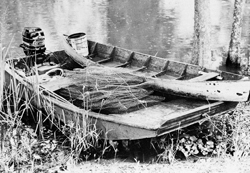
Once logs became scarce, pirogues were built of cypress planks, and since cypress planks have become scarce, they have been built of marine plywood. These new boats evolved from dugouts, greatly resemble them, and are used for the same purposes as dugout pirogues. It is not surprising, therefore, that they are almost universally called "pirogues," even in north Louisiana, though sometimes they are called "plank pirogues" to differentiate them from dugout pirogues. These modern pirogues still resemble dugouts in use today in the following ways they are relatively short, averaging 12 to 14 feet; they are slightly wider near the bow, as the run to the stern is longer; the bottom is flat and ends at a ridge at the bow and stern; the gunwales are slightly flared, and curve slightly toward front and rear; small fillets reinforce the bow and stern; two thwarts are in the craft, the one to the rear being the seat; and a strip of molding is placed on the outside top edge of the gunwales.
Pirogues are used almost exclusively in swamps or marshes. Narrow pirogues are used for hunting and fishing in swamps, as they are an ideal craft for traversing a wooded area, and in swamps they are always paddled.6 Pirogues are also commonly used in coastal marshes for trapping, and in this area they are usually wider and longer, and are either paddled or poled. In the marsh pirogues are used in narrow man-made canals, called trainasses (Davis l976; and Kammer 1941: 104), and are portaged between lakes where canals do not exist. These small light craft are never used in a large river, because of the danger of swamping. The highest concentration of pirogues is in southern Louisiana, but they can be found throughout the state. The pirogue does not lend itself to mechanization. On a few the rear end is cut off and a transom added to support a small outboard motor, or an inboard engine is used, but neither approach is truly successful. As a result, today's pirogue, never used for long distance travel, but rather only for a few specialized purposes, is declining in significance.
The Skiff
The skiff (esquiff) is of an ancient design, and examples of this boat type are found in many parts of the world. The term skiff refers to any small flat-bottomed craft with a sharp bow and square stern, but throughout the Mississippi River system it is recognized as a particular boat type. The distinguishing features are intangible, but it is a boat type recognized by all who make their living on the water.7 The first skiffs were used along the Upper Ohio by 1800 (Comeaux 1978: 76), and as the design was well known by the French, skiffs were probably used in Louisiana long before that date, though this has not yet been proven (Knipmeyer 1976: 134). The problem is one of terminology. Almost any boat with a pointed bow could be called a skiff, and boats resembling skiffs had very specific names, such as peniche, chaloupe,8 and galere (Knipmeyer 1976: 134). One early writer, however, saw "real skiffs made of planks of varying timbers in the European manner" that were made in Louisiana before 1805 (Robin 1966: 100), so skiffs, or variations of modern skiffs, were undoubtedly in Louisiana very early.
Three varieties of skiffs soon evolved. The major difference between the types was in the shape of the stern. Names to identify the skiff sub-types varied from one region to the next, but in Louisiana they have been termed the "Creole skiff," the "Mississippi skiff," and the "lake skiff."9 The Creole skiff is the smallest. It has the narrowest beam, the greatest amount of sheer and rake out of the water at the stern, and the transom is V-shaped, often times as narrow as two inches at the bottom. The lake skiff is the largest and widest, and has a stern that is wide and almost rectangular. The Mississippi skiff is intermediate between the two.
Each of these skiff types has attributes that largely determine use and distribution. The lake skiff is the most stable, seaworthy, and capable of carrying the heaviest load, so it is usually found along the large coastal lakes and bays or in the Mississippi River. The Creole skiff is least stable but is easiest to row, and it is usually found in inland waters, particularly in the Atchafalaya Basin. The Mississippi skiff has some of the virtues of each. Fishermen have always recognized merits of the various types, and try to get a craft that fits a need. Skiffs have delicate lines, and true skiffs could never be built by inexperienced fishermen, so they have always been built in small boatyards scattered along the Mississippi River.10
One unique feature of some skiffs in south Louisiana is the method used in rowing them. A device known as a joug elevates and extends the tholepins and straps beyond the side of the craft (Knipmeyer 1976: 140-42). This allows for easy rowing while standing and facing forward (Fig. 5). It is used especially on the Creole skiff, but can be occasionally found on other craft. It is a technique that was introduced from southern Europe, where such a method of rowing boats is common.
Traditional skiffs are now very rarely seen in north Louisiana, and only a few survive in south central Louisiana. The skiff is a boat designed to be rowed, and when internal combustion engines were introduced, the skiff began a slow decline in popularity, as it is not really ideally suited to carry either an outboard motor or an inboard engine. Inboard engines were put in skiffs, and a large skiff with such an engine is called a canotte (Knipmeyer 1976: 135), but few if any exist today.11 There were, however, two specialized types of skiffs that evolved to handle engines, and one of these is now known as the "Lafitte skiff," though locally made skiffs are sometimes known by other terms, such as the "Delacroix skiff" from St. Bernard Parish.
Lafitte skiffs are indeed skiffs in the general form of the boat, though much larger than other skiff varieties. They are designed to work in shallow waters behind and along the coast. Lafitte skiffs are now found widely used along the Louisiana Gulf Coast, especially in the inland shrimp industry. These are sleek craft with powerful inboard engines, which today are usually Chevrolet or Oldsmobile engines converted to marine use. Constructing a Lafitte skiff is difficult, so they are usually built in small "shipyards" by specialists, but they are also sometimes built by individual fishermen.
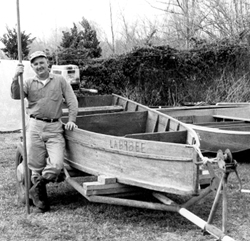
The other skiff type to evolve for use with an engine uses an outboard motor. It is called by no special name by its users, and only referred to as a "skiff," but it is quite different from traditional skiffs. This boat evolved in the Atchafalaya Basin, and is very popular there, so should be termed the "Atchafalaya skiff." In order for a boat to use an outboard engine efficiently, it must be able to plane, and this skiff, as is also true with the Lafitte skiff, is modified in order for it to do so. The gunwales do not rake up at the stern, but rather the bottom extends straight back from the center, and the rear bottom is very broad. Since there is little sheer to the gunwales, it is an easy boat to build, and if of wood, it is usually built by the owner. With the pointed bow, which usually has little rake, the Atchafalaya skiff can be driven through the water hyacinth which now chokes many of the streams and swamps, and it can push aside small trees in a swamp, so it is widely used in overflowed lands, especially by crawfishermen (Comeaux 1972: 68).
The Flatboat
The flatboat is today the major boat used by folk fishermen in inland waters in Louisiana, and this boat type is found along all river courses. Although there are many flat-bottomed boats, to river people there is only one "flatboat." The major characteristics that identify a flatboat are: an oblong shape with a blunt bow (scow bow) and stern, a flat bottom, and vertical or slightly flared sides. These characteristics will, in general, identify all craft belonging to the flatboat group. This flatboat family has gone through a long evolution, as they have been easily adapted to new technology, and there are many varieties of flatboats.
Flatboats evolved from the large barges moving goods downstream to New Orleans. These barges developed in Europe, were used along the United States eastern seaboard, and at some unknown but early date were introduced into the Mississippi River system (Johnson 1963: 131-33, 141-45). Evidence that early flatboats evolved from barges is circumstantial but strong: a barge was commonly called a "flatboat," and a primitive flatboat in French Louisiana is called a chaland,12 meaning "barge" in standard French; flatboats, though smaller, resemble barges in form; construction of early flatboats and barges was similar (built upside down with bottom boards running athwart rather than lengthwise); and small barges resembling early flatboats are still built by fishermen.
The first flatboats were developed by fishermen. If a fisherman could not afford to buy a skiff but needed a boat larger and more stable than a pirogue, he would build a flatboat. Flatboats were easy to build, as they were oblong, with little or no sheer to the sides, and the bottom boards were nailed athwart. The ends were raked slightly upwards, with the bow narrower than the stern. This construction made them easy to paddle or row, highly maneuverable, and quite stable (Comeaux 1978: 82-83). This early flatboat was never as good as a skiff, but it would suffice.
A few of these early flatboats are still being built, but they are not very common. In the French area they are called chaland, and in north Louisiana "paddle boat," though local names to identify this craft abound (Knipmeyer 1976: 131-33). They are today usually built of marine plywood, which greatly simplifies construction and gives them greater strength. Today the chaland and the paddle boat are used only for short trips. In the French area it is common to stand while paddling a chaland across a stream.
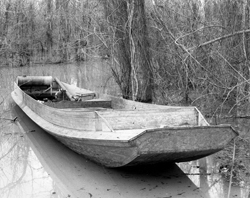
Changes in the design of the flatboat began when small internal combustion engines became available soon after 190013 (Comeaux 1972: 42), for the flatboat, when modified, was ideally suited for use with inboard engines. The major changes in the flatboat were to double the length, so that the average was well over 20 feet (but it was not greatly widened); the run forward was made much greater than the run aft; a rudder was used; and the bow rose high out of the water because of a large amount of forward sheer. There are many names for this type boat, such as joe boat, john boat, gas boat, launch, and putt-putt, but in French Louisiana the term "bateau" is most widely used.
Whereas the French word bateau means the same as "boat" in English, in south-central Louisiana it always refers to this type of craft. The engine used in the bateau was a small two-cycle engine, still affectionately called a "putt-putt" by older river people; there was even a company in Plaquemine that manufactured putt-putt engines.14 A few boats of this type were made particularly large, had powerful engines, and were used in swamps as traveling stores and as fish-buying boats.
The bateau was once widely used, but its popularity declined rapidly. In 1956, up to 60 percent of all boats in the Atchafalaya Basin were bateaus (Knipmeyer 1976: 144), but now there are only 4 or 5 left, and these are kept for nostalgic reasons. The reason for the decline of the bateau was again developing technology. Outboard motors were first developed soon after 1900 (Casson 1964: 257), but by the 1950s they had been perfected and had gained acceptance. The long, heavy, and slender bateau could not be made to plane, so could not be efficiently used with an outboard motor, and it was quickly discarded.
Many boats of the bateau type survive in the upper Mississippi River system, where they are usually called "launches." In this region it has been common since the 1920s to use automobile engines in this craft, and sometimes even marine engines. With such an engine they are very powerful and can be used for special chores, such as in seining or as small tug boats. This type craft is sometimes seen in Louisiana pushing the houseboats of drifters. Since it was unusual to put such large engines in bateaus in Louisiana, powerful outboard motors could do much more work than a putt-putt, and there was thus another reason for abandoning the bateau. In the future, however, should a need arise among folk fishermen in Louisiana inland waters for a powerful boat that need not plane, a bateau with a powerful engine will probably quickly develop.
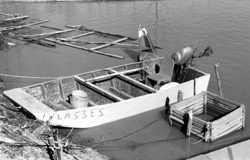
The boat that developed to complement the outboard motor evolved from the flatboat family, and it is now the only craft commonly referred to today as a "flatboat." This boat differs from earlier flatboats in several respects: the bottom is made of marine plywood; it is wider, widest just aft of the waist, where it has a beam of about three feet; the stem is broad and has no rake out the water; finally, it is considerably shorter than a bateau, averaging sixteen feet. Though shorter, the rear hung engine of a flatboat allows work space equal to a bateau. The flatboat's major advantage when equipped with motor is speed; the all-day trip of a bateau can be accomplished very quickly. The flatboat also uses less gas as it planes on top of the water, rather than plowing through it. The flatboat is now far and away the most common boat on Louisiana inland waters, and this fact is true throughout the entire Mississippi River system (Comeaux 1978: 84). The only difference between flatboats used in the French and Anglo areas is that flatboats made in south Louisiana are usually of much better quality, sturdier, and better maintained. Locally made, very heavy gauge aluminum flatboats are now gaining acceptance by commercial fishermen. Small factory-made aluminum flatboats, too light and unstable for use by commercial fishermen, are now widely sold for use by sportsmen; no greater compliment can be paid to the often maligned folk-oriented flatboat.
Barges, from which flatboats evolved, still survive in Louisiana and are still built by folk fishermen. Except for their smaller size,15 they resemble the early barges once used in hauling goods from the Ohio River to New Orleans. The main use of barges today is for handling large, heavy, and awkward loads, such as for seining, ferrying or as a base for a houseboat. Houseboats (also called campboats) are built on bargesand so should be considered a part of the flatboat family.
The origin and evolution of houseboats is unclear. They probably evolved from "Orleans" or "New Orleans" boats that carried goods between the upper Ohio and New Orleans, and they were often used as floating stores. These Orleans boats were relatively small and narrow and had an arched roof extending bow to stern (Johnson 1963: 136). "Kentucky" boats were also popular at the same time, but Orleans boats were different; Kentucky boats were larger and had a flat roof that did not extend from bow to stern, leaving part of the bow uncovered. A view of Orleans boats that greatly resembled modern houseboats was sketched as early as the year 1828 (Samuel et al. 1955: 23). After this date, it is not unusual to see sketches and photographs of similar craft on the Mississippi. It is unknown when fishermen, drifters, wood cutters, and other river people began living in them as permanent homes, but it was apparently not very early, as it was not mentioned by early writers. A visitor to the Atchafalaya Basin in 1888, for example, did not mention houseboats, but on several occasions he mentioned the "huts" of fishermen (Coulon 1888), huts that were undoubtedly under water for part of the year, for houses in swampy areas near rivers and streams in the Mississippi River system were never built on stilts to avoid the annual spring flood. It must have been soon after 188S that houseboats were adopted, for six years later there were 173 houseboats in the Atchafalaya Swamp (Smith 1898: 539), and by 1922 that figure had grown to 679 (Sette 1925: 197). Houseboats were very popular in the early part of the twentieth century, and they could be seen along all major streams, not only in Louisiana, but in the entire Mississippi River system. Most were occupied by fishermen, and almost all towns along major streams had one used as a fish market.
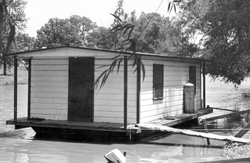
The typical houseboat is as wide as the hull supporting it, about 10 feet, and only rarely is there a catwalk extending beyond the hull along the side. They are about 35 feet long, one room wide, and three feet deep, with the front room a living room, the second a bedroom, and the rear room a kitchen. There is a small porch on the bow, and the roof is low and arched (some today have a low gable). Most houseboats in Louisiana today are abandoned or are pulled onto shore and occupied there.
Coastal and Offshore Craft
Boats used in coastal and offshore situations are different from boats used in inland waters. In this environment, stability is of critical importance, and boats here are much more seaworthy than those found on inland waters. Many are flat-bottomed and designed for use near-shore and in the large bays and lakes behind the coast, while others have deep V-shaped hulls for use offshore.
The flat-bottomed boats commonly used along the coast are numerous, but the craft can be grouped into several categories. One of these is the Lafitte skiff. This skiff evolved from large Mississippi skiffs that were rowed in coastal waters in the early days of the shrimp industry, when seines were hauled by hand (these were known as "haul seines"). (16) Today these skiffs, powered by large engines, are very popular, and their main advantage over other types is their speed (most can do 30 miles per hour, or better) and maneuverability.
The traditional inland and near-shore craft is the lugger. This craft evolved from sailing boats native to the Mediterranean that were introduced and used along the Louisiana coast, and they got their name "lugger" from their Mediterranean rig (Padgett 1960: 190). When gas engines were introduced, the sailing luggers declined rapidly, as the motorized luggers evolved. The new luggers resembled sailing luggers except that the centerboard casing was omitted, and a cabin to house the engine and operating controls was placed at the rear (Becnel 1962: 23). They were small flat-bottomed craft, 20 to 30 feet long. Later more seaworthy luggers were introduced, and they are called "Biloxi oyster luggers," as they originated in Biloxi, Mississippi (Padgett 1969: 489). The Biloxi oyster luggers are from 40 to 50 feet long, had more of a V-bottom, and had greater freeboard. They were thus more seaworthy than the local luggers, and they became quite popular for close offshore work (Becnel 1962: 24). Luggers are noted for being particularly slow, but in the days of sailing ships, when these boats were each fitted out with a single large lugsail, they were "celebrated" for their quickness (Mathews 1928: 330).
Luggers are closely associated with oystermen who came to this country from the Dalmatian Coast (Padgett 1960: 243), and who possibly introduced the craft, or at the least modified and popularized it. It is still the only major commercial oystering boat, and when used for this purpose luggers are easily recognized because of the boards along the sides several feet high. Many are used also in shrimping and found rigged for the otter trawl. Luggers today are found widespread along the Louisiana coast where inland lakes and bays abound.
The potential for Louisiana offshore shrimping was discovered in 1937, and in 1938 Florida fishermen introduced a seaworthy fishing boat, as well as many new mechanical techniques (Anderson, et al. 1949: 3-4). Local Louisiana residents could not have rapidly developed this industry, as they did not have a suitable craft, nor did they have the necessary technical knowledge, techniques, or capital, and so outsiders initially dominated offshore shrimping. The newly introduced shrimp boat is known as a "South Atlantic trawler," and it is a large boat, 50-65 feet in length, and sometimes even longer. Small versions of this boat are called simply "shrimp trawler," and are commonly used in bay and near-shore shrimping, whereas the larger variety are referred to as "Florida-type shrimp trawlers," and are used in deepwater. Since they generally have a deep draft, deepwater ports are needed, and Florida-type trawlers are commonly seen concentrated at such suitable ports. Both trawler types can be considered true folk boats, as they have been accepted by locals, and they are constructed in both shipyards and back yards, and are built in both wood and steel. Other boat types should be mentioned. The crew boats used in the oil industry are powerful sturdy craft that are designed for offshore work. It is a widely recognized type that is constructed by local boat-builders, but it has yet to be studied in detail. Vietnamese fishermen have recently come to the Louisiana coast, and they brought with them their concepts of how a boat should be built. Whether or not any of these Vietnamese ideas are successful and later accepted by others along this coast remains to be seen. Menhaden fishing is also very important off the Louisiana coast, but this is a very mechanized, capital-intensive operation, rather than a folk industry, and the boats employed are not folk boats.
Other Craft
There are other craft that simply do not fit categories. One of these is the raft (cajeu), which is made of logs or reeds. Indians used such rafts (Delanglez 1964: 272; and Le Page du Pratz 1774: 362) as well as the early French (Surrey 1916: 58-59), but they were never important or used for long in this early period. The only time rafts were important was during the early cypress logging era when large rafts, called "cribs," were used by swampers (Coulon 1888: 10). These cribs were crude affairs and were later abandoned as living quarters when comfortable bunk-houses, called "quarterboats," were built on barges.
Another type of boat was a strange craft used in transporting live fish from a swamp area such as the Black River in north Louisiana (Gregory 1966: 9). It was called a "tow-car" (also "live-car," "fish-car," "well-car," and "live-boat"). The tow-car was made with bulkheads on the ends, and the sides were of slats. It was towed empty into swamps, riding high in the water with the bulkheads empty, and as fish were purchased from swamp dwellers, it was lowered by filling the bulkheads with water, and the live fish were added to the central section. Tow-cars were probably first used in Louisiana in the 1870s (Comeaux 1972: 31) and were the first successful technique allowing the commercial movement of fish from a swamp. They remained important until artificially manufactured ice began to be used to keep fish "fresh" (about 1899). Fish mortality rates were so high in tow-cars that they could not be used in summer months, and only hardy kinds of fish could be transported in even the best of conditions. The use of ice allowed the efficient movement of all fish from the swamp at any season, and so the tow-cars declined rapidly, the last one used in Louisiana about 1918 (Comeaux 1972: 35).
Many other boat types have been omitted. Some are not folk boats, and others were folk boats used in the distant past, beyond the memories of informants. Such boats were not covered, especially if they did not evolve and do not have lineal descendents used today as folk boats. Examples of boats in this category are keelboats and bateaus (not to be confused with the earlier-mentioned bateau). Both of these were built of planks and designed for long distance travel along inland waterways in the 1700s and early 1800s (see Johnson 1963: 63-103, 152-80). There were also many boat types used along the coast and lower Mississippi that fit this category, such as frigates, ketches, brigatines, barques, chaloupes, and others.
Summary and Conclusions
The folk boats of Louisiana provide a good example of how culture, environment, and technology interplay to cause changes in boats and to determine how and where boats are used. Culture goes a long way in influencing how people perceive and use boats; as, for example, how boats are rowed facing backwards in north Louisiana, while in south Louisiana it is common to stand and row facing forward. In general, the people of French descent in south Louisiana have a more developed boat tradition than those of Anglo descent in north Louisiana, due in part to greater environmental need. In south Louisiana boats are better built, better maintained, and have more meaning in the lives of local people.
No culture in Louisiana is in complete isolation, and new ideas are always being introduced.17 These new ideas are accepted or rejected, and the determining factor seems to be whether the new idea or concept is a success or failure when adapted locally. Small inboard engines were placed in pirogues, and a few of these can still be seen. But it was not a successful marriage, and the technique was rejected with only a few being made. Inboard engines could be used with the flatboat, however, if the flatboat was modified. This was done and a new boat type evolved: the bateau. The skiff, meanwhile, was meant to be rowed, and did not easily lend itself to the use of inboard engines. Eventually skiffs in coastal areas were modified to carry inboard engines, and the Lafitte skiff evolved, but in inland waters the idea did not work, though the canotte was an attempt to combine the two. The same sort of story happened when outboard motors were introduced. Occasionally an outboard motor is seen on a pirogue or true skiff, but it is only efficiently used with flatboats or Atchafalaya skiffs, boats that evolved to complement the outboard motor. Developing technology, therefore, had a tremendous influence on boat types, as well as their evolution and use.
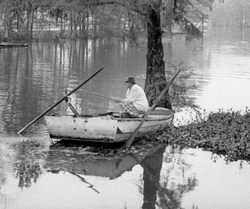
The environment also played a role in determining boat type, evolution, and use. Offshore boats are very different when compared to those that work coastal bays and lakes. The same is true for inland waters; boats used on large rivers, such as flatboats, differ from those used in swamps, such as pirogues or Atchafalaya skiffs. Before deciding on a craft, a person will always consider the environment that is to be exploited.
There are many kinds of boats in Louisiana, and each has been designed to fill a particular role. Some have been abandoned, particularly since advancing technology has made some types obsolete, such as the chaland, the canotte, the true skiff, and the bateau. Others, meanwhile, fit an environment or chore so well that they have not changed, nor been abandoned, such as the pirogue and barge. What has been surprising about boats in Louisiana, however, were the rapid changes in the flatboat family as technology was introduced. Boats were adjusted to that technology, and new types evolved and were readily accepted.
Notes
1. Certain colors predominate. Almost all pirogues are painted green (Knipmeyer 1976: 115). Most flatboats are painted gray, with red trim. Most large coastal boats are painted white, and again with red trim.
2. The word "Pirogue" is a Carib Indian word meaning "dugout." The Spanish adopted the word and spread it to the English and French in the New World. It was a widely used term in the American South and was spelled many ways, such as penauger, pirage, pretty-oager, petiaugua, penagua, and others.
3. Origin and evolution of the pirogue is well known. The best study of pirogues in pre-historic times is that by Johnson (1963: 20-54) and that for contemporary times is by Knipmeyer (1976: 108-130).
4. There is one exception to this rule. One authority on Indians (Swanton 1911: 345) mentions the Chitimacha, who lived along the southern edge of the Atchafalaya Swamp, as having elm bark canoes. In pre-historic times, birch bark canoes extended only as far south as northern Illinois (Johnson 1963: 81).
5. In other areas where cypress would not grow (as north of the Arkansas River), many other woods were used (see Johnson 1963: 52-54).
6. Paddles are made of cypress, and when made today the wood comes from an abandoned cistern or sometimes from an old picket fence. This wood is light, will not become water-soaked as other woods, is well seasoned, is easy to carve, and is long lasting. They are usually about five feet long, have a T-shaped handle, and a blunt or slightly rounded blade.
7. Details for making a skiff can be found in U. S. War Department (1909: 218). The example is identical to skiffs used on the Mississippi River at the turn of the century, only larger.
8. The chaloupe was quite different from the skiff and unrelated to it, as it had a keel (Johnson 1963: 63). Most chaloupes were lug-rigged, two-masted fishing boats used in coastal waters.
9. Elsewhere in the Mississippi River system they are known as the "fuller-fisher" (Creole Skiff), "half- fisher" (Mississippi skiff), and "yawl" (lake skiff) (Comeaux 1978: 78). Only the term "yawl" is widely used, and almost all river people along the Mississippi know the word.
10. This writer knows of only one remaining skiff factory, the Weaver Skiff Works on Racine, Ohio. It was established in 1869, and today produces 75 to 125 skiffs a year.
11. One writer states that the canotte evolved from the lugger and was used in particularly shallow water (Becnel 1962: 7). It had a hinged keel that slid into a casing in the boat whenever it hit bottom.
12. Also, an informant once told this writer, when asked to describe a chaland, that it was "nothing more than a very small barge" (Bourque 1968).
13. Louisiana fishermen were not slow in motorizing their craft in comparison to other Mississippi River fishermen, for the first boat with an engine in Lansing, Iowa, an important fishing town, was in 1910 (Carlander 1954: 59).
14. Most old informants in the Atchafalaya Swamp stated that the Lockwood-Ash engine was made in Plaquemine, but it was not that simple. The Lockwood-Ash was originally made in Michigan by the Lockwood Motor Company and sold to Sears, which sold them under the trade name "Sears Motor-Go." Most swamp dwellers purchased their engines from Sears, and the Lockwood-Ash was by far the most popular engine used in Louisiana rivers and swamps. The Nadler Foundry and Machine Company (now Nadler Incorporated) of Plaquemine began repairing these engines and bought parts from Sears, but later bought them directly from the Lockwood Motor Company (which is now part of Outboard Marine Corporation, manufacturers of Evinrude and Johnson outboard motors). In the early 1920s the Lockwood Motor Company quit making Lockwood-Ash engines, and the Plaquemine firm bought the patent rights and began manufacturing them, calling them "Nadler" engines (swamp dwellers, however, continued calling them "Lockwood-Ash"). The Nadler Company produced these engines until the early 1950s. The Lockwood-Ash engines were made in four models, two and one-half four horsepower single cylinder models, and six and eight horsepower two cylinder models. The Nadler Company built all but the six horsepower version. Many of these engines survive in the sheds and shops of old swamp dwellers and are in surprisingly good condition.
It can further be noted that the addition of certain engines in some cases transformed the basic range and use of a boat. The "mudboat" craft are powered by "enormous" automobile engines. During high water they can plow a trainasse (trough or ditch) through the marsh. This usage is restricted apparently to the chenier plain area.
15. Johnson (1963: 116-21) gives contemporary descriptions of early barges. Details for building a small barge are given in U. S. War Department (1909:217-18). This account explains how to launch the boat upside down and have the current flip it over, was the folk way of doing it (see also Stacy 1941:21-22). All small barges are today turned over by hand before launching.
16. These seines were set out in a large semi-circle, and then they were manually pulled to shore (Johnson and Lindner 1934: 12-13).
17. New ideas today are commonly thought of as technological rather than cultural, i.e., ways to fabricate a particular style of boat or new materials to use rather than overall design. However, Nicholas Spitzer reports that the cultural influence of the Vietnamese on the Gulf Coast has already resulted in the introduction of a south Asian boat type called a tchuen. Built currently in Biloxi but sold to Louisiana Vietnamese shrimpers, the boat is smaller than most shrimp trawlers with a sharp V bow but an overall shallow draft. The result is a very maneuverable craft that can work well inland and in deeper waters. The Vietnamese are also duplicating the more common South Atlantic and Florida-type shrimp trawlers.
Bibliography
Anderson, W. W., M. J. Lindner and J. E. King. "The Shrimp Fishery of the Southern United States." Commercial Fishery Review. 11(2)(1949): 2-27.
Becnel, Thomas Aquinas. "A History of the Louisiana Shrimp Industry, 1867-1961." Master's thesis, Louisiana State University, Baton Rouge, 1962.
Bourque, Albert. Personal Interview. "Commercial fisherman in Bayou Benoit, Louisiana" October 21, 1968.
Carlander, Harriet Bell. A History of Fish and Fishing in the Upper Mississippi River. Upper Mississippi Conservation Committee, Davenport, Iowa, 1954.
Casson, Lionel. Illustrated History of Ships and Boats. Doubleday and Company, Garden City, New York, 1964.
Comeaux, Malcolm L. Atchafalaya Swamp Life: Settlement and Folk Occupations. Geoscience and Man Series, 2. Museum of Geoscience, Louisiana State University, Baton Rouge, 1972.
_____. "Origin and Evolution of Mississippi River Fishing Craft." Pioneer America. 10(1978): 73-97.
Coulon, George A. 350 Miles in a Skiff Through the Louisiana Swamps. George A. Coulon, New Orleans, 1888.
Davis, Donald W. "Trainasse." Annals of the Association of American Geographers. 66(1976): 349-59.
_____. Personal communication, Professor, Nicholls State University, Thibodeaux, June l5, 1982.
Delanglez, Jean, ed. and trans. "The Journal of Pierre Vitry, S. J., 1738-1740." Louisiana Studies. 3(1964): 250-309.
Glassie, Henry. "Introduction" to "Folk Boats of Eastern French Louisiana," by William Knipmeyer. In American Folklife. Don Yoder, ed. University of Texas, Austin, 1976.
Gregory, Hiram F., Jr. "The Black River Commercial Fisheries: A Study in Cultural Geography." Louisiana Studies. 5(1966): 3-36.
Johnson, John Amos. "Pre-Steam boat Navigation on the Lower Mississippi." Doctoral dissertation, Louisiana State University. Baton Rouge, 1963.
Johnson, Fred F., and Milton J. Lindner. "Shrimp Industry of the South Atlantic and Gulf States: With Notes on Other Domestic and Foreign Areas." U. S. Bureau of Fisheries, Investigational Report No. 21. Washington, D. C., 1934.
Kalm, Peter. The America of 1750; Peter Kalm's Travels in North America: The English Version of 1770, Revised from the Original Swedish and Edited by Adolph B. Benson... With a Translation of New Material From Kalm's Diary Notes... Dover Publication, New York, 1966.
Kammer, Edward J. A Socio-Economic Survey of the Marsh-dwellers of Four Southeastern Louisiana Parishes. Catholic University of America, Washington, D.C., 1941.
Knipmeyer, William B. "Folk Boats of Eastern French Louisiana." In American Folklife. Don Yoder, ed. University of Texas, Austin, 1976.
Le Page du Pratz, Antoine Simon. Histoire de La Louisiane. 3 Vols. de Bure, Paris, 1758.
_____. The History of Louisiana. Louisiana State University Press. Baton Rouge, 1975. Originally published by T. Beckett, London, 1774.
Mathews, J. H. "Fisheries of the South Atlantic and Gulf States." Economic Geography. 4(1928): 323- 48.
Newton, Milton B., Jr. "Blurring the North-South Contrast." In The Culture of Acadiana: Tradition and Change in South Louisiana. Jon L. Gibson and Stephen L. Del Sesto, eds. University of Southwestern Louisiana, Lafayette, 1975.
Padgett, Herbert R. "Marine Shellfishes of Louisiana." Doctoral dissertation, Louisiana State University, Baton Rouge, 1960.
_____. "The Sea Fisheries of the Southern United States, Retrospect and Prospect." Geographical Review. 53(1963): 22-39.
_____. "Physical and Cultural Associations on the Louisiana Coast." Annals of the Association of American Geographers. 59(1969): 481-93.
Penicaut, Andre. Fleur de Lys and Calumet: Being the Penicaut Narrative of French Adventure in Louisiana. Richebourg G. McWilliams, trans. and ed. Louisiana State University, Baton Rouge, 1953.
Robin, C. C. Voyage to Louisiana 1803-1805: An Abridged Translation From the Original French. Stuart O. Landry, Jr., trans. and ed. Pelican Publishing Company, New Orleans, 1966.
Sette, Oscar E. Fishery Industries of the United States, 1923. U. S. Commissioner of Fisheries, Report for the Fiscal Year 1924, Appendix IV. Government Printing Office, Washington, D. C., 1925.
Smith, Hugh McConnick. Statistics of the Fisheries of the Interior Waters of the United States. U. S. Commission of Fish and Fisheries, Report of the Commissioner for the Year Ending June 30, 1896, Appendix II. Government Publishing Office, Washington, D. C., 1898.
Stacy, Miles A. "Flatboat Reminiscences." In "Flatboating on the Great Thoroughfare." Josephine E. Phillips, ed. Historical and Philosophical Society of Ohio, Bulletin, 5(2)(1947): 11-24.
Surrey, Nancy Maria Miller. The Commerce of Louisiana During the French Regime, 1699-1763. Columbia University, New York, 1916.
Swanton, John R. "Indian Tribes of the Lower Mississippi Valley and Adjacent Coast of the Gulf of Mexico." Bureau of American Ethnology Bulletin 43. Government Printing Office, Washington, D. C., 1911.
U. S. War Department. Engineer Field Manual, Parts I-VI. Professional Papers of the Corps of Engineers, U. S. Army, No. 29. Third (revised) Edition. Washington, D. C., 1909.
Waud, A. R. "Ferry-Boat to Brashear City, on Berwick Bay, Louisiana." Harper's Weekly. 10(1866): 664.


